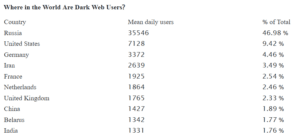Free Guide
16 Questions You MUST Ask Before Hiring Any IT Company
The dark Web has become a mainstream topic in recent years due to a significant rise in illegal activities on several dark web forums. A likely explanation for this sudden rise is the increased bandwidth of The Onion Router (Tor) browser, savvier cyber-criminals, and cybercrime’s continued success. The dark Web holds the world’s third-largest economy, which is growing, which is bad news for businesses.
The world wide Web (commonly known as the Web) comprises three sections: the Surface Web, the Deep Web, and finally, the Dark Web. The content of the surface web, which consists of 10% of the total content, can be accessed using standard search engines such as Google, Bing and others. The deep Web consists of the other 90% of the Web’s content hidden is typically gated behind a password or paywall, such as company intranets, online banking and most social media. Regular search engines cannot index the information on the deep Web. You need the Tor browser to navigate the extent of the Dark Web by cloaking them with a veil of anonymity.
Take a look at traffic patterns on The Onion Router (TOR), the most popular dark web browser:

Source: TOR
Like the Bermuda Triangle – a small region in the western part of the North Atlantic Ocean where many aircraft and ships are said to have disappeared – the dark Web is also a tiny and infamous portion of the deep web hotbed of all the nefarious activities. For a layman, it is an unexplorable area, but for wicked cybercriminals, it is their workplace — a lucrative space for money-making. Cybersecurity Ventures predicted that the dark Web would inflict about $6 trillion in damages worldwide in 2021, and they were on the mark.
Although the dark Web offers a legitimate space for identity protection to journalists and political bloggers living in countries with the threat of censorship and political imprisonment, those aren’t the only people using the dark Web. Dark web forums are hotbeds of criminal activity. Popular activities on dark web sites and forums include trafficking illegal goods, guns, drugs, intellectual property, stolen data and cybercrime tools and services like black hat hacking.
Among the services bought and sold on the dark Web, 90% are from people looking to hire hackers who can infiltrate websites and steal databases. Another 7% of people on the dark Web are hackers who offer Hacking as a Service (HaaS) to potential buyers. Many of these service providers provide exciting offers to their clients as there has been a significant rise in the forums offering HaaS in recent years. The remaining 4% of dark web traffic comes from the people frequenting dark web forums for hacking services related to website hacking and malicious code injection and meeting with like-minded professionals.
Cybercrime as a Service (CaaS) is a booming business with many branches, including Phishing as a Service (PhaaS) and Ransomware as a Service (RaaS). Hiring cybercrime contractors is cheap and easy. PhaaS follows the Software as a Service model (SaaS) many legitimate tech companies use. In a PhaaS scenario, bad actors engage cybercriminals developers to cook up the elements of a phishing campaign like false sign-in page development, website hosting, spoofed emails and credential parsing. PhaaS operators can also perform a wide variety of minor a la carte services like hosting a single phishing site or providing a template for a one-time send. A PhaaS group’s subscription prices vary depending on a host of factors, but generally, the service can cost about $800 per month. That’s a worthy and affordable investment for ransomware groups looking to score hundreds of thousands of dollars in ransom money every month.
While many assume highly skilled programmers are behind ransomware or other malware, many cybercrime groups don’t write their code; they might not even have personnel who know how to write it. Instead, malware is commonly packed as plug-and-play software with a user manual. An estimated 300,000 thousand new pieces of malware are created daily. Malware as a Service (MaaS) and its offshoot Ransomware-as-a-Service(RaaS), is a business model that uses ‘pay-and-use’ malware for conducting cybercrime. The dark Web is set to significantly contribute to the rise in global ransomware damage cost, predicted to exceed $265 billion annually by 2031.
With the significant growth of the dark Web, the markets have everything from social media credentials, business credentials, and critical business information to credit card details. According to the Dark Web Price Index 2022, cybercriminals can acquire credit card details and online banking login information for as little as $50 from various dark web marketplaces, forums, and websites. The same research revealed that hackers on dark web forums sell a variety of stolen data, such as:
Scammers can buy all the necessary credit card details, such as CVV number, card number, and associated dates, enabling them to perpetrate digital fraud quickly and easily. With the rapid growth of the cryptocurrency market, many dark web forums also sell digital wallets of platforms such as LocalBitcoins and Coinbase for less than $250. Credentials are also a hot commodity. Cybercriminals can quickly get their hands on vast quantities of credentials snatched or stolen in cyberattacks, sometimes without spending a dime. Researchers at Digital Shadows have determined that 24.6 billion complete username and password sets are available on the dark Web.
Source: ID Agent